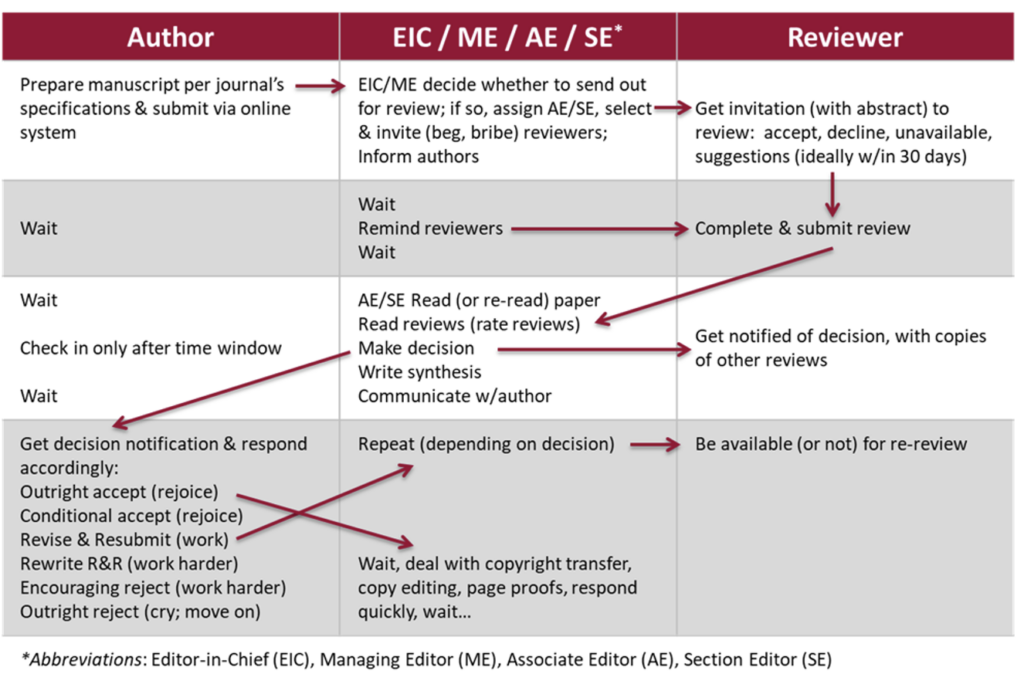
Greetings fellow evaluators! My name is Shannon Hitchcock, PhD (she/her/hers) (aje.managingeditor@gmail.com), and I am a quantitative sociologist, public health evaluator, and, since February 2023, the Managing Editor of the American Journal of Evaluation. I am here to discuss the peer review process. The content of this blog post is based on a presentation given by AJE Co-Editor, Dr. Laura Peck, and me this past October at the annual American Evaluation Association conference held in Indianapolis, IN.
How the Review Process Works
Lots of arrows incoming! You can gather from the figure below, the peer review process is a marathon (along a winding and hilly road with ongoing construction), not a sprint. And here’s why – there are a ton of folks involved who each have an important role in ensuring published articles are high-quality, grounded in conceptual frameworks, methodologically sound, move the field forward, and offer food-for-thought or directions for future research. All this important work is done through unbiased, double-anonymized peer review. Beyond a stellar manuscript that checks off all those boxes, each journal also has its own focus. For AJE, we consider manuscripts that focus on evaluation theory, practice, and methods that would be of interest to a reasonably sized share of the journal’s readers. It has to be a good fit!

At AJE, we strive for a 60-day review process turnaround, which involves deciding if a manuscript should go out for review, assigning an Associate Editor (AE) or Section Editor (SE), sending out reviewer invitations, assigning reviewers, giving reviewers 30 days to complete reviews, allowing time for the AE/SE to recommend a decision, and giving the Editor-in-Chief (EIC) time to review and act on a decision. Based on the decision, this process repeats. There’s a lot of waiting. There’s a lot of reminders. As Managing Editor (ME), it’s my job to keep those trains moving.
Lessons Learned
- A delay at any point during the peer-review process slows all trains. This one keeps me up at night. Our goal at AJE is to turn manuscripts around in a timely manner, but if any of the steps along the peer review process get delayed, so does the overall processing time.
- Be kind to yourself and others! Editors generally have been published plenty, been rejected plenty more, and done many reviews independent of their editorial responsibilities. They get it! We want reviews to be useful, provide direction, and we want to give you a decision quickly.
- Only bug if it’s time to bug. That being said, when authors badger editors for updates, ignore reviews, and act entitled, then editors get grumpy and do not take extra steps to move the process forward any more quickly.
Hot Tip:
Thoughtfully and thoroughly respond to reviews.
First, congrats! Revised and resubmitted manuscripts are judged on their responsiveness to reviewer and editor feedback. Be sure to express gratitude to the reviewers who volunteered their time to thoughtfully review your work. Address each comment explaining what you did, where, and why, or, why you chose not to incorporate reviewer feedback. Tables are helpful here!
The American Evaluation Association is hosting the American Journal of Evaluation (AJE). All posts this week are contributed by evaluators who work for AJE. Do you have questions, concerns, kudos, or content to extend this AEA365 contribution? Please add them in the comments section for this post on theAEA365 webpage so that we may enrich our community of practice. Would you like to submit an AEA365 Tip? Please send a note of interest to AEA365@eval.org . AEA365 is sponsored by the American Evaluation Association and provides a Tip-a-Day by and for evaluators. The views and opinions expressed on the AEA365 blog are solely those of the original authors and other contributors. These views and opinions do not necessarily represent those of the American Evaluation Association, and/or any/all contributors to this site.
